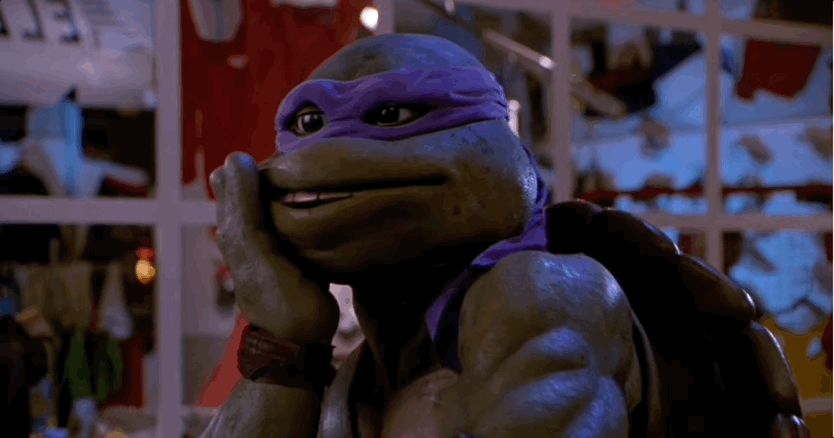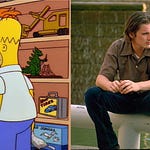In the middle of a YouTube rabbit hole research for this newsletter, I found myself watching videos from Coming Out of Their Shells, a live event that featured the Teenage Mutant Ninja Turtles.
This is one of the more bizarre artifacts of Turtle-mania (I wrote about another one here). Actors in Turtle suits visited local arenas and lip-synced1 to pop songs about pizza, friendship, overcoming peer pressure, and other wholesome topics you’d expect a group of adolescent reptillian superheroes to sing about. Besides the tour, there was an album, VHS tape, and pay-per-view event. I loved the Turtles, but my love was limited to the toys and cartoons. Live-action Turtles were played by people in suits wearing animatronic heads. The mechanically animated facial movements on top of naturally moving human bodies separated the characters into a wise-cracking kid on top and a fierce martial artist below. The whole appeal of the Turtles was the package of personality. In movies and live shows, the Turtles just raised too many questions about metaphysics and the true nature of the mind (though I now appreciate the craft of the costumes made by Jim Henson’s Creature Shop).
Coming Out of Their Shells also muddied the Turtles mythology for me. In the cartoon and movies, they were always hiding in shadows and under bulky trench coats so no humans would ever see them. Didn’t their career as rock stars cancel the need for subterfuge while fighting crime? Or were these supposed to be the real Turtles, who played themselves in movies? I had friends who saw the tour and I never knew if they thought the Turtles were people in suits, or the real Turtles. It seemed like too much for my favorite cartoon characters to also exist in real life. Maybe this explains why I never got into pro wrestling, either.
When I watched the Coming Out of Their Shells video, these questions came rushing back to me…and they brought something else with them. I could vividly place myself in the living room of one of my childhood friends, this video playing in the background and me jealously watching him show off the features of his new Turtle Copter. I could even remember the Glade Plug-in scent of his house.
Some of the YouTube videos had TV station logos on them, or listed what was on next. With these, I got a more general memory. I could remember that time when Saturday morning cartoons were ending and a matinee movie was about to start. The movie was whatever the station could afford to get through syndicators, and was never very interesting. The feeling of this time of day was the feeling of finally needing to go outside and play—to aimlessly ride my bike up and down the street looking for other kids who had also hit a TV wall.
While looking for a video from the Sonic the Hedgehog game for a recent newsletter, I played a clip that opened with the the bitcrushed sing-songy “Sega” jingle that played whenever you turned on a Sega Genesis. I immediately felt the feeling of being inside on a warm afternoon with the midday sun hitting my face through a closed window.
You probably have experiences like this, too. It’s not the memory of a particular show or movie or game from childhood—it’s a very precise memory of the situation you were in when you saw the show or played the game. It can be one specific time or a mix of generalizations based on specific sense memories. For example, when I see the shade of bluish green that was the default color of the Windows 2000 desktop, I can feel of the texture of the molded plastic chairs from my high school computer lab, along with a vague sense of dread from being assigned a seat next to the class bully. Certain songs take me back to where I was when I first heard them.
These feelings can be nostalgic on their own. Maybe you like molded plastic chairs or spending warm days inside with a 16-bit video game console. But they also feed into the nostalgia we have for certain media. When we watch TV, we don’t just remember what we watch, we remember how we watch. The event of viewing gets logged just as much as the content of the program. “Television is remembered and felt as a significant experience that can illuminate histories and memories of the self and the family,” Professor Amy Holdsworth in her book Half the World Away: Television, Space, Time and Memory.
This isn’t limited to movies or music. In a recent interview, food writer Helen Rosner addressed the popularity of pieces she’s written about Olive Garden, chicken tenders, and other examples of what she calls “Mass food.” That food is the stuff of day-to-day experience, and people respond to Rosner celebrating it.
“The small moments of filling up the car with gas with your dad and he buys you a Hostess cherry pie and that becomes your special ritual. That’s not me saying the Hostess cherry pie is the greatest food in the world. That’s me saying that moment with my dad was an important moment. And because food is more than just food, because that moment was important, the Hostess cherry pie is the greatest food in the world.”
This doubling up of memories makes nostalgia for objects and artifacts extra powerful. Rewatching a movie we loved in childhood brings back the moments we watched it—on the couch with Mom, laughing together; home sick from school under a blanket with the taste of cough medicine lingering; at a sleepover trying to keep heavy eyelids open to stay up all night; or when we realized we might be a little too old for childish things. The experiences make us who we are. And the more we remember them, the more central they become to us. Our meaning is built on memories. And our memories are tied up with media.
No wonder we have so many sequels. Bringing back a character is an attempt to bring back a memory in the audience. And no wonder some people get so angry about reboots and re-assessments. They defend old kids movies as classics because the experiences they had watching them were so foundational. Both the studio executive green lighting a new installment of an old franchise and the guy posting an angry tweet about it are guided by the same conflation. They each confuse the movie with the memory.
We’re not wrong to have this association, but we can avoid the confusion. The difference is that movies and TV shows and video games are in the world for everyone to experience. That experience is the result of a specific circumstance that enhances our enjoyment. We should celebrate the relationship between the moment and the media. Because that moment is what memories are made of. And unlike media, the memories we form are not for everyone. The memories are ours. And no one can change them.
Can it really be called lip syncing if they don’t have lips, though?
















